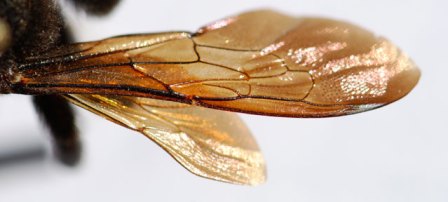Now the answers from last week’s wing identification mystery:
1. These dark wings belong to a female carpenter bee, Xylocopa californica. Bees, wasps and ants have a forewing larger than the hindwing.


2. Flies have only one pair of wings. This is from a crane fly, Tipula sp.


3. Yes, you can see most of the cicada’s back. This is a Diceroprocta sp.


4. Moths and butterflies have veins in their wings under the covering of scales. This is a moth, but I don’t know the species.

5. The true bugs have wings that are half leathery and half membranous. This is a shield or stink bug.

6. The wings with many, many veins are from a dragonfly.

Sara, you deserve a clapping of wings (and hands) for recognizing them all at least to order. Awesome!
 It is resting on a vining milkweed plant, although it might have crawled to there from some other type of plant nearby.
It is resting on a vining milkweed plant, although it might have crawled to there from some other type of plant nearby.










